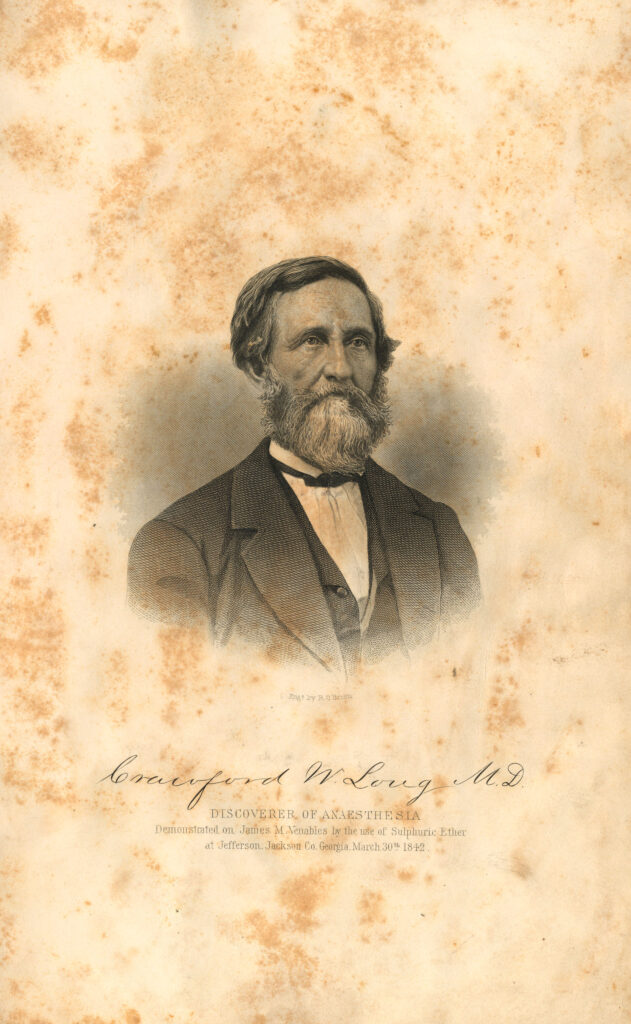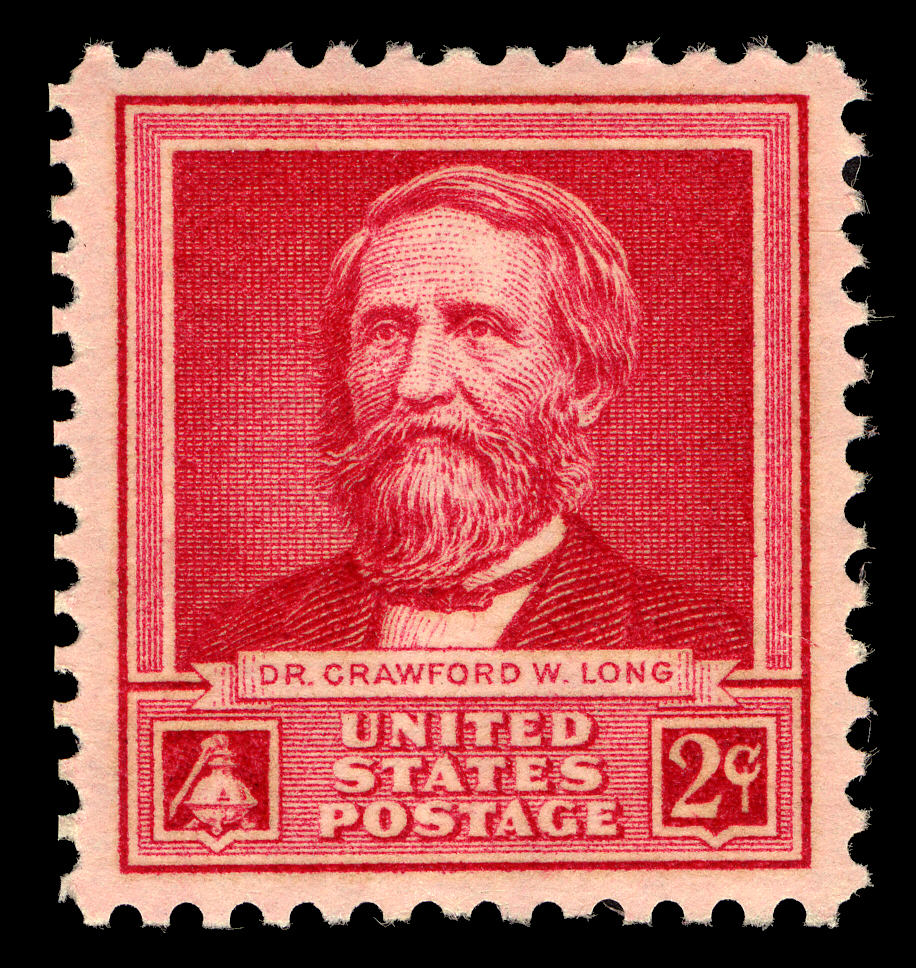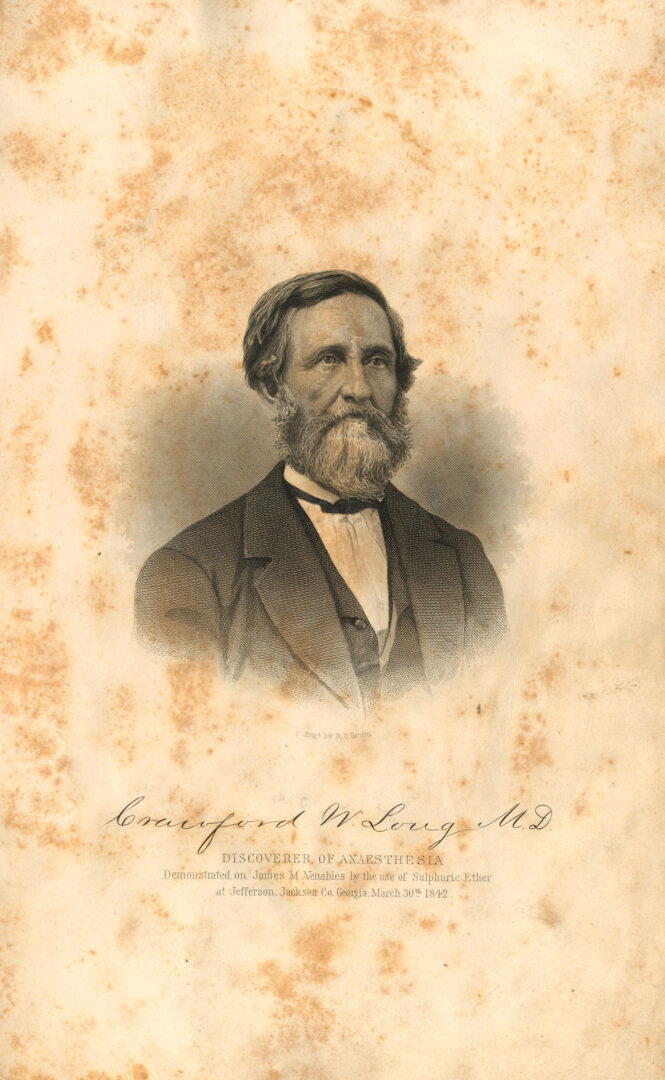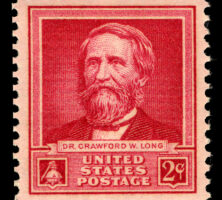Crawford Long, a north Georgia physician, is credited with the discovery of anesthesia. Long County, in southeast Georgia, is named in his honor, as was Crawford Long Hospital (later Emory University Hospital Midtown) in Atlanta.
Crawford Williamson Long was born on November 1, 1815, in Danielsville, the seat of Madison County, to a wealthy merchant and planter. (He was also a cousin of famed gambler John Henry

Courtesy of Tina Harris, Crawford Long Museum
After one year at Transylvania College, Long transferred to the University of Pennsylvania in Philadelphia. There he had the opportunity to study with some of the greatest medical scholars of the day and to witness new medical techniques firsthand. He received his medical degree in 1839. After a hospital internship in New York City, Long returned to Georgia to take over a rural medical practice in Jefferson (in Jackson County) in 1841.
During his medical school years Long observed traveling showmen who demonstrated hypnotism and sometimes the effects of nitrous oxide, or “laughing gas,” on the crowds. At school Long had also witnessed antics at laughing gas parties and “ether frolics,” in which participants would inhale nitrous oxide or sulfuric ether for entertainment. He observed that attendees often fell or bumped into things but seemed to feel no pain until the effects of the gas wore off.
As he established his medical practice, Long began to experiment with sulfuric ether as an anesthetic. He performed his first surgical procedure using the gas on March 30, 1842, when he removed a tumor from the neck of a young man. Though he performed more surgeries using anesthesia over the next several years and began using it in his obstetrical practice, Long did not publish his findings. Many doctors were skeptical that the use of gases or other chemicals during surgery would provide pain relief, and Long wanted to be sure of his discovery. He made no secret of his investigation among his colleagues and friends in Jefferson, however. Some local residents thought that Long was engaging in witchcraft. Others believed that he was disturbing the natural order of things and that pain was God’s way of cleansing the soul.
An editorial ran in the December 1846 issue of Medical Examiner about a Boston dentist named William Morton who claimed to have used ether as an anesthetic. The January 1847 issue featured several articles about various experiments in etherization. After reading these accounts, Long began writing his own account of his discovery and collecting notarized letters from former patients. In 1849 he presented his findings to the Medical College of Georgia (later Georgia Health Sciences University) in Augusta, and while there he learned of two others who also claimed to be the discoverers of surgical anesthesia—Horace Wells and Charles Jackson. The ether controversy was well under way before Long made his claim. Although the others sought wealth and fame for the discovery, Long simply wanted the recognition of his peers and to alleviate the suffering of patients. An article about his discovery, along with copies of affidavits, was published in the Southern Medical and Surgical Journal in December 1849, but Long did not receive full recognition for his discovery in his lifetime.

Courtesy of the Smithsonian National Postal Museum
In the intervening years his family and his medical practice grew. Long married Caroline Swain in 1842, and together they had twelve children, seven of whom survived to adulthood. In 1851 they moved to Athens, where Long opened a practice and pharmacy with his brother, Robert. During the Civil War he remained in Athens and served as a surgeon to soldiers on both sides of the conflict. He died on June 16, 1878, shortly after helping to deliver a baby.
On June 18, 1879, the National Eclectic Medical Association (an organization that advocated using the best remedies that could be found, from many different sources) passed a resolution declaring Long as the discoverer of anesthesia. Since that time he has been recognized by medical bodies all over the world and has been memorialized by monuments, statues, paintings, a U.S. postage stamp, and Doctors’ Day, celebrated every March 30. A museum in his honor stands at the site of his medical practice in Jefferson.







